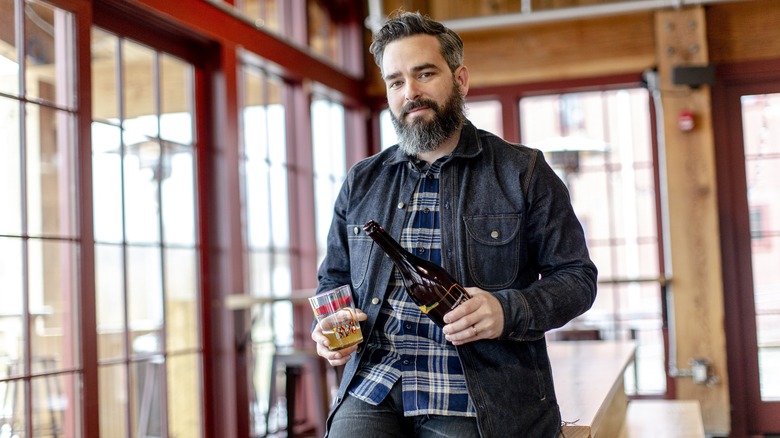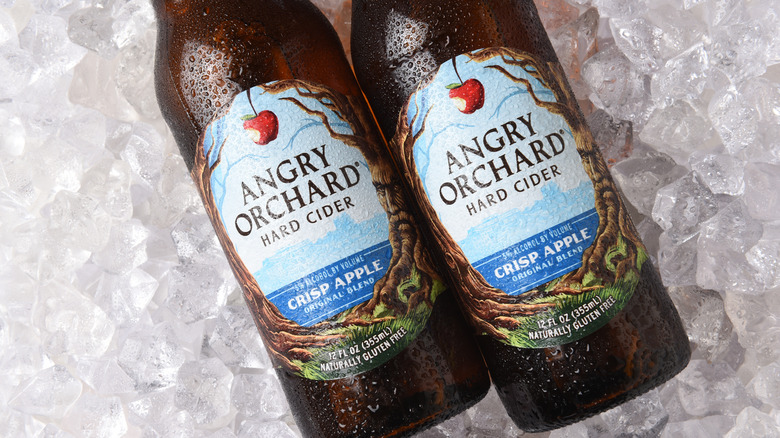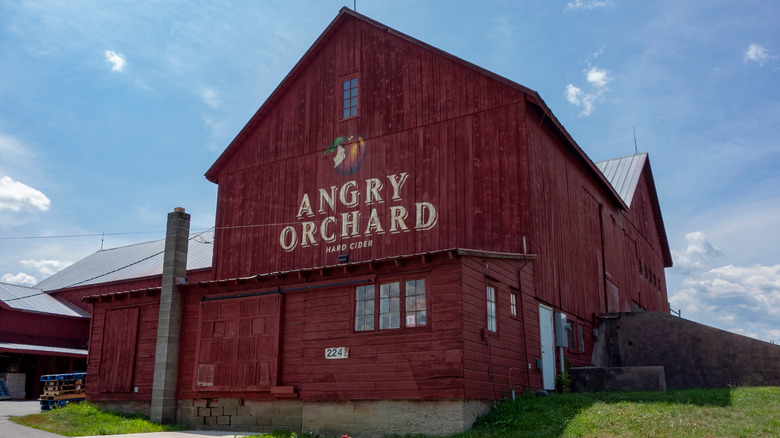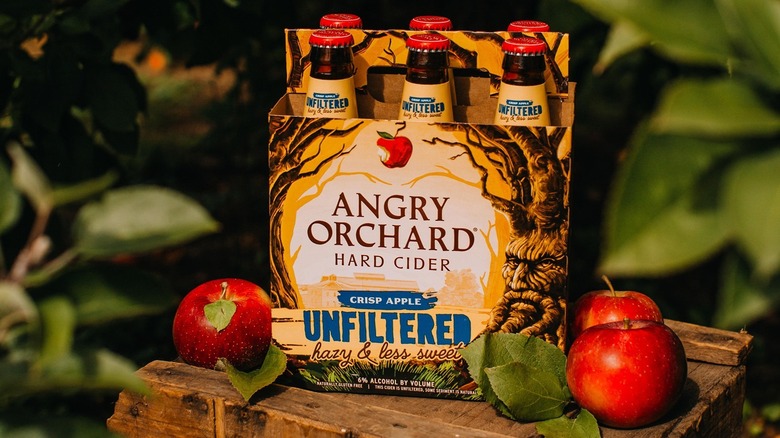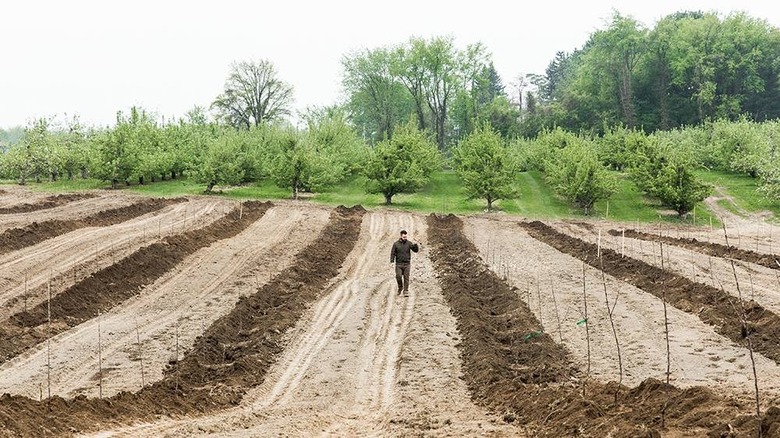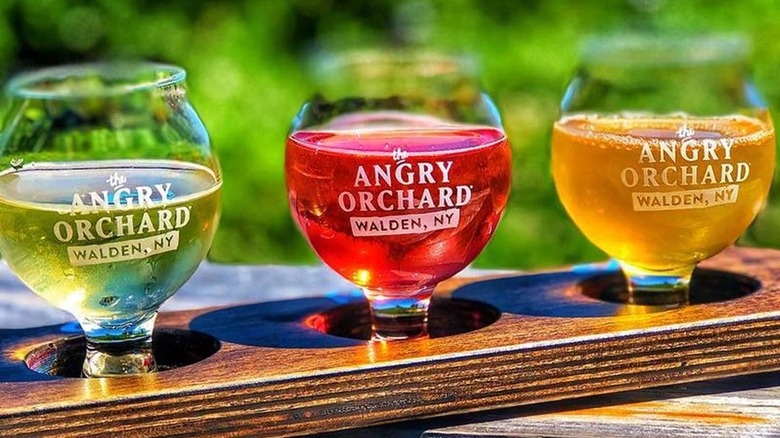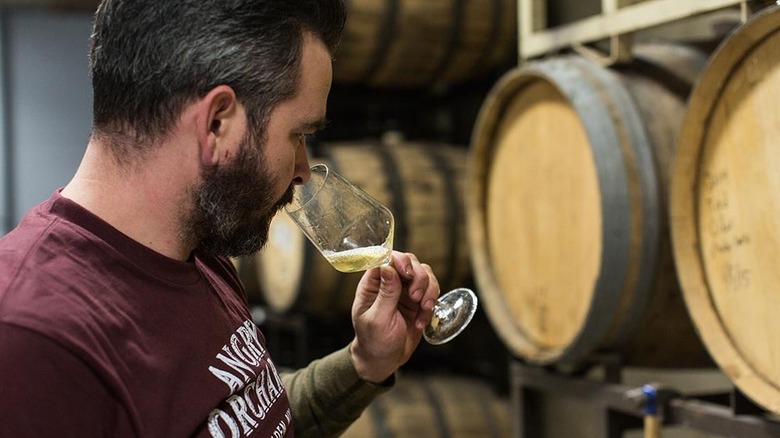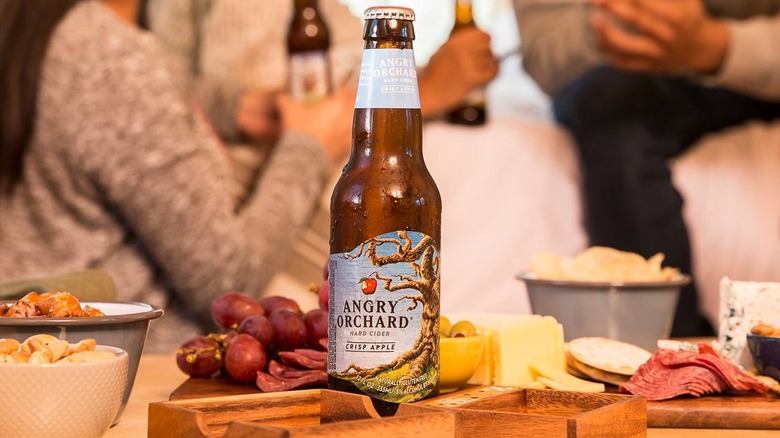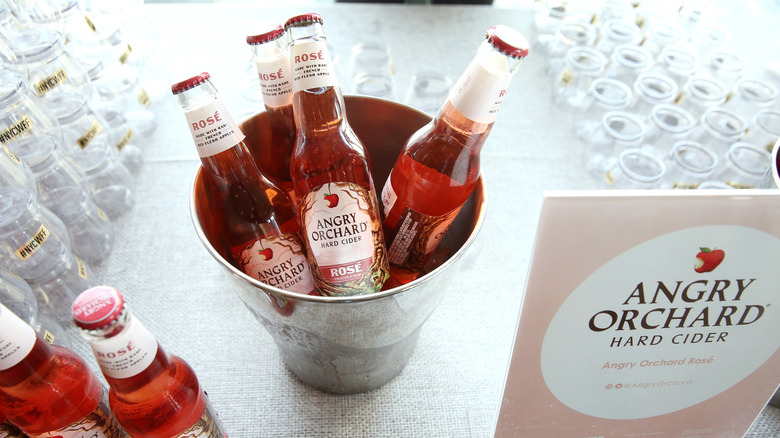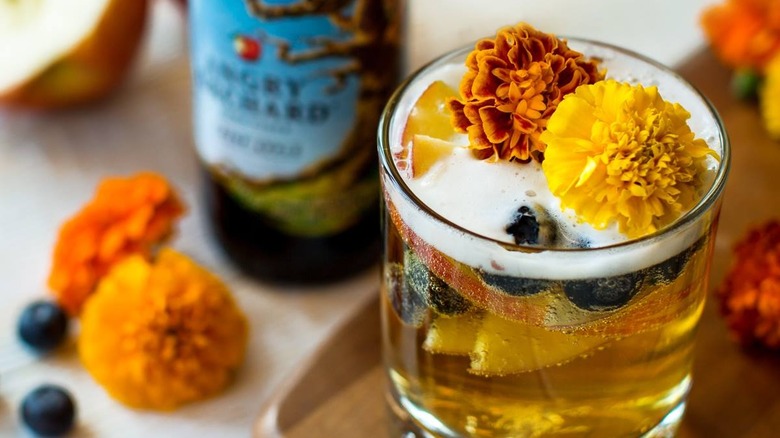Cidermaker Ryan Burk Tells Us Everything About Angry Orchard - Exclusive Interview
Years ago, thinking about hard cider brought up images of leaves falling and pumpkin patches, along with the idea that cider was a syrupy sweet drink only meant to be enjoyed with cold weather. But that's certainly not what's being produced by cidermakers today, as they work to showcase a balanced beverage that's approachable to everyone. And one of the cider industry leaders that's working to change that perception is Angry Orchard's head cidermaker, Ryan Burk.
With changing that perception comes the need to define hard cider for what it really is. It's not beer, and it's not wine. Many don't know that it's made from apples. And even though Angry Orchard undoubtedly leads the U.S. market in cider sales, there's still quite a few myths about cider that need to be debunked, according to them.
To learn more about Angry Orchard, we decided to go straight to the source. We talked with Burk about the misconceptions of the cider world, where the apples come from, new projects in the works, and even the best food to pair with this delicious, effervescent drink.
The history behind Angry Orchard's name and its best-selling cider
What's the history behind the name Angry Orchard?
We wanted it to be a playful brand, and I think that we've always been that way. But we also wanted to tie it to something. There's a bit of a whimsy to it, and I think one of the fun parts is the fact that you even asked me that question. People are always asking "why is the orchard angry," or "why are the apples angry." And so, it gives us a door to open. It opens up a pathway to conversation about why the orchard is so important, and why varieties of apples matter.
It's a nod to a couple of things. First and foremost, it's a nod to the orchard. In the fall, especially with big, old cider trees, usually the European variety, which is kind of a lost thing in America, you have these big 30, 40 foot trees in orchard lanes and all the leaves come off. All the apples are gone, and they're these big, gnarly trees. And it kind of has this whimsy sort of gnarly appearance. Angry is that sort of nod to that, that vision of an orchard. It's a nod to the varieties of apples we use — apples grown specifically for cider making, which is the basis of Angry Orchard, and Crisp, our flagship cider. It's the sort of secret success of that cider. Maybe most Crisp drinkers might not know that these traditional cider apples that are grown specifically for cider making are in that, but it's the thing that makes it special. And those apple varieties that are grown specifically for cider production, they don't look pretty, they aren't for the grocery store. They don't necessarily look or taste pretty. But as a cider maker, you can taste them and know they're going to make great cider.
So, it's a nod to those apples as well. This sort of angry, gnarled apple that's being turned into something a little bit more edgy than your kid's grocery store apple, but it's actually being turned into enjoyable alcohol.
All of it is kind of just like a playful illusion to the things we care the most about. And like I said, it opens that conversation. Because, I would say unfortunately, one of the challenges of the cider industry is getting people to understand what it's really all about and where it comes from, and there's a lot of misnomers on cider beer and things like that. So, driving the story of quality based on the ingredients that make us special has always been central to our story.
Which Angry Orchard cider offering would you say is the most popular, or that you're making the most of?
Crisp, our flagship that we opened the doors with back in 2011 is by far our most popular SKU.
Ryan Burk shares what makes Angry Orchard different than other ciders
What makes Angry Orchard cider different than other hard ciders?
Well, a lot of things. I think our attention to balance is what drives our success. So, I'll speak to Crisp, our flagship, which continues to lead our business.
First, I'll point out that cider is not one thing, it's a diverse category, which we as an industry have a hard time defining, and we're always trying to. I'm on the board of the American Cider Association, and one of the things that we are always trying to develop is the language, and how do we make categories, and competition categories, and all that stuff. It's very hard. And getting a group of cidermakers in a room to try to define it? Good luck to you.
So, in a spectrum of ciders, in a lineup of ciders, Crisp could be on the sweeter side of a spectrum of dry to sweet. Definitely over medium, and that's fine. Sweet cider is fine. But it's about how you balance that sweetness. And for us, the key is the use of traditional cider apples to balance that. So, when I say that, I'm talking about tannin. Tannin gives us that thing, that weight, that allows us to do other things. So for me, and for the ciders that we make, we kind of always start with those traditional varieties, and we build off of that because we want to find balance.
When you think about Angry Orchard from a national perspective, I mean, we're in 50 states plus, we serve a lot of different people. And the general cider drinker, not the craftiest nerdiest cider drinker, but the average cider drinker across the country, tends to want to drink sweeter things. And while we have dryer things in the national market, the things that sell the most are usually sweeter things. And that's true, not just for Angry Orchard, but for everybody.
So, for us, it's about how do you manage that? How you balance it? How do you have a complex, interesting drink that also is well balanced, and that balance is what brings people back. And I would say, it's the reason Crisp continues to thrive the way that it does, even as other styles come in and out. For instance, Rosé was a huge bang, and it's still around, but Crisp continues to grow. Crisp continues to stick around and isn't going anywhere. It's that balance that brings people back.
That thread goes across all of the cider that we make down to the smallest thing that we do in Walden (the location of the Innovation Cider House, in New York, where Burk creates new recipes). It's finding that balance between the levers that we have to pull, which, from my perspective, are acid, tannins, and sugar or not, or in some degree. We're always kind of moving those levers to make something balanced that is a complete thought. For instance, very rarely would I have a very high acid cider that was also sweet without any tannin to balance that out. That approach, I think, is the hallmark of what we do across the entire spectrum of our ciders.
What people get wrong about hard cider, according to Ryan Burk
What is one of the most common misconceptions that you hear about hard cider? What do you need to set straight?
There's a few. The cider beer thing comes up quite a bit. And we even have people within the industry that will call it brewing cider for instance. But brewing, like in coffee and tea, and certainly in beer, is a function of making something available, and that's fermentable sugar. We have fermentable sugar right out the gate. It's very easy, and it's also very simple sugar. So, it's not like beer where there's a lot of residual sugars. We have a simple sugar, it's very fermentable. Essentially any apple will turn into cider. That doesn't mean that it'll turn into good cider, but it will make alcohol. I think that's the number one confusion point.
I can understand the confusion in the sense that cider is most like wine. However, it's most served like beer. It's on the draft line. It's often in a pint glass. It's right next to beer. It could be in a firkin. It could be in a barrel. I mean, all the same ways that it gets served. Now certainly there are a lot of still and dry ciders that are in 750s and larger, and corks and cages, and all that kind of stuff, but the primary cider is sold kind of like beer out of a keg or in a can. So, I get the confusion. But there's certainly a thick dividing line between process. And yeah, that definitely comes up the most.
And also, that misconception can get in the way of the fact that we're working with apples. What makes wine special, right? It's like, okay, Pinot Noir makes wine special. Chardonnay makes wine special. These varieties that you can speak to, and people can grab onto that, they know that they can expect something. I love Chardonnay, so I know what I'm going to get when I buy a Chardonnay. Not necessarily always, but generally. And so getting people to understand that with cider, in my opinion, I think in the cider industry's opinion, the more educated we can get people on what we're actually doing, the better off we'll all be. And sort of getting that cider beer thing out of the way is key to that success, I think.
Ryan Burk dishes on where all the apples used for making Angry Orchard ciders are grown
Where do the apples come from? Are there certain growers that you're working with annually that are the staple growers for Angry Orchard?
Yep. So, we have a lot. When it comes to our national production, the fruit comes from the Pac Northwest.
Yakima Valley area?
Yep. And then Normandy and Brittany in France. That's where we get the high tannic, traditional cider apple varieties. They're not grown in any quantity in the U.S. that would serve the purposes of Angry Orchard production. And then also from the Alto Adige region of Italy. Those are the three main places. Sometimes, there's some New York State fruit or other state fruit, but on average, those three places are where the bulk of our production comes from.
Then when we start to narrow the view down to Walden and what we're doing in New York State, the pool gets a little bigger, actually. We grow a lot of our own fruit first and foremost. We're on a 60-acre orchard, and we consume all the fruit on this orchard. Some of it stays here on the property, and some of it does go into our national cider production, so Crisp will have fruit grown on our orchard.
Oh wow. So it's semi-estate grown.
Yeah. So, it's got a little bit of estate fruit in it. And then at Walden, we work with a lot of the estate fruit here, but we grow mostly high tannic, bittersweet, and bittersharp apples here. We don't really grow a lot of high acid varieties, which we need for balance. We don't do that because New York State is such a great state for high acid fruit, especially if you go up along the coast of Lake Ontario, which is where I'm from. So, just to be transparent, I have some preferences, but I have preferences because they deserve to be preferred. Some of the finest apples grown in the world are along Lake Ontario, certainly for eating purposes, but for cider making purposes as well. And there's a couple of things that make it distinct. One, the climate is really interesting for varieties that take a little bit longer to mature, to really express themselves. So, apples like the Northern Spy, which we use a lot of, there's a lot grown up there. And to really be pristine, it needs to hang on the tree a little bit longer than the average picking dates. But because it's right on Lake Ontario, the warm air that comes off the lake keeps the coast a little bit warmer a little bit longer. So, we can hang fruit a little bit longer, and that is special in and of itself.
What's also special is a lot of the varieties that are grown up there used to be grown for the juice industry. And the juice industry apples 30, 40 years ago were these varieties that cider makers are really interested in now from a high acid perspective, such as Newtown Pippin, Northern Spy, and a few others. They were just the apples that people used, but they've fallen out of fashion. Nobody eats them really anymore. But the cider makers love them... So what used to go into single stream Mott's juice, that's where Mott's is located by the way, is now highly valued by cider makers.
Up along that coast, we work with a lot of different growers, and we do come back to them year after year. The more we work with them, the more we can have a say in how that fruit is grown, and we pay a premium for that. n ciders. The Finger Lakes are also a place where we buy a lot of fruit, and also New Hampshire is a place that we buy a lot of traditional hard cider varieties. So yeah, kind of all around.
That's the main stuff, but I don't limit exploration here necessarily by what's local. I would say 90 percent of what we do here is made with apples grown within 100 odd miles of here, maybe 200 odd miles of here. But if we find something cool in Virginia, then we're getting it. We found some fruit in Oregon grown by a guy named Kevin Zielinski. He has a cider brand called E.Z. Orchard, and he has all of this fruit that's traditional French varieties that no one else is really growing. He's got some to spare, and it's amazing fruit, and we've made some of the best ciders that we've ever made out of it. We ship it across the country in totes because, why not? Because it's amazing.
Where Ryan Burk draws inspiration for developing a new Angry Orchard cider
What's your process for developing a new cider, and where does that inspiration come from?
Definitely, cider is my core focus in and outside of work, but I love to look elsewhere to find inspiration. And I probably look to cider the least for inspiration, especially when it comes to the small production stuff that we do in Walden. I try to put blinders on when it comes to cider.
A lot of inspiration comes from food. I don't separate cider from eating. That's impossible for me, so I don't eat food or drink cider without thinking about the other one. Because of that, I also look to a lot of other categories, often wine. I spend a lot of time around wine. I find the most inspiration there because it has set a standard for that experience. Well, first off, I believe cider can at least match up to that experience, if not better. And one of the reasons is that cider is usually half the alcohol. I like that about cider when it comes to eating because I like to drink when I'm eating, and I like to have a good time. And cider allows me to try more and have a better time with less booziness attached to it, although usually it depends on the dinner. We might have too good of a time.
I spend a lot of time thinking about how wine does things very well, and how can I do those things with cider. How can I at least be this good? And I think it can get very challenging in the white wine world, or the orange wine world, or the glou-glou, natty wine world. There's nothing that...well, I shouldn't say nothing, but there's a lot of things in all those spaces that cider can at least match up to. It gets harder in the red wine world. The more robust the tannin gets, the harder I think cider can compete, but we're working at it, right? It's like, how much tannin can you put in the cider? How far can we drive it? And also, do we really want to do that anyway?
So, I find a lot of inspiration there, and that's where our more terroir driven ciders, things that are going to end up in 750 ml bottles or 375 ml bottles come from.
I think about what can cider do that Champagne does? That sort of space. I don't like to use the words high-end when it comes to cider, because I just feel like it's not, like we're not. The most expensive bottle of cider is like 30 bucks. That's one of the benefits of cider is that it's affordable and accessible, and it should stay that way.
I find cocktail bars to be the most innovative space in all of the drinks category. Because just from bar to bar, there's a difference. Well, first off it has standards, which I love. And then it has variations on standards, which I love. And those variations can switch from bar to bar, from person to person, from shift to shift. So, it's a mind numbing amount of creativity at all times. Plus, then just new s***. Plus finding some old Polish aperitif that all of a sudden someone revived, and now you can get it at Death & Co. And then they... make 20 new cocktails in five minutes. It just like, oh my God, how can you... And that's Tuesday. You can't keep up with it all. I find that to be really inspirational, and I like to spend a lot of time around the cocktail world to just absorb that.
And so how do we come up with new ideas for fruit ciders? Well, we're working on a tea. Or it's not even tea, it's tisane. So it's non-caffeinated, it's dried Korean pears. I went to this tea/cocktail bar in New York City called 29B Teahouse, and they've focused on Korean and Japanese teas. They have this whole range of things that are non-caffeinated, like lotus root or lotus blossom, and et cetera, et cetera, et cetera. And they're making cocktails out of it. I'm like, oh, this could be cool. So, we're working on that now. It's fun to explore those spaces for inspiration.
And also, I would say the farmer's market is a good place for inspiration. We kind of have a general rule here. Well, not kind of, we have an absolute rule in Walden that if we are going to do something with an ingredient, then we should at least be able to find it fresh within season. Now, sometimes with Korean lotus root, that's not the case. But when it comes to what we think fits within what we're trying to do and the story we're trying to tell, we try to go get it as locally as possible what's grown in season.
The innovative projects in the works at Angry Orchard
What other kind of innovative projects do you have in the works right now?
Let's see. Sometimes, I just think these things are exciting, and maybe not innovative. But one thing that we are just releasing now in our cider club, and actually at the orchard for the first time, is a cider called Five-Year Cider. And it's called that because it's been sitting in barrels for five years. And I know it can be a tired story, that story of, "...and then we found this barrel, and it was lot 42, and now it's called Lot 42," that kind of thing. But this is truly one of those stories where we probably have 600 odd individual barrels on the farm at any time. And sometimes things just sit around for too long, and this is one of those things. We were going through barrels to dispose of, because five years is a little long to push a cider. The way we do things is sort of in a micro-oxidative way. We don't really do a lot of topping off. We kind of accept and celebrate and then work it into our blending process a little bit of oxidative characters, sort of like ala sherry and other similar drinks. As we were going through barrels, we just happened to come across these barrels that were sitting there from our first vintage, which was 2015 here in Walden. Six went down the drain, four were immaculate. They were just unbelievably beautiful ciders. We blended those together in a little 375ml bottle, and we're putting that on sale for our one year late, ala COVID, five-year anniversary. So that's a really cool thing. And for me, it's innovative in the sense that it just happened to be pushed to that degree.
But we do a lot of pushing to certain degrees that I don't necessarily see in a lot of American cider making. Maybe more in European, Spanish, and even more so English cider making, where we're really pushing the boundary on what we can do in a barrel and in aging in general. It's not that it hasn't been done before, but I don't see it a lot here. And maybe it's been done before, but just sort of as a function of, well, things just kind of sit around. We're really looking at how far can we go, and how can we take it and make interesting drinks that are special and unique to this place.
Another thing that we will release this year is our Pommeau, a French aperitif or digestif, depending on how you want to drink it. So, it's 70 percent apple spirit, which is of our own cider. We can't distill onsite. We distill right up the road from here. And then it's blended with 30 percent fresh apple juice.
Will that be a national release, or that's specific to Walden?
Well, that'll be specific to Walden. So, we've been doing it for four years now, and what we've done is built a solera out of it. We're releasing the first bottling of it in a couple of months. I know it's labeled. We're going to cap it. It's here. What's cool about it and sort of different is this solera method, sort of sherry-esque, approach to making Pommeau, which is not how it's traditionally made. So we've got pyramids built and we're pulling off the bottom and then filling at the top. It's really, really special. It's very oxidative and heavy, like dried fruit and sort of overripe orchard. It's cool, special, and not like anything I've really ever had before. And this is just the first bottling, so I'm psyched to where this can go again. How far can we push this thing?
And I think one other, just in the realm of apples, is that we do a lot of work with Cornell and other partners in New York to, again, kind of explore how far and what can we do with apples in this state and in different terroirs. So, we are planting experimental varieties here at our orchard and around New York State via Cornell. We've also planted the same varieties across the state at various orchards. And we're starting this project now where we start to analyze that fruit by tasting it. We're doing singular fermentations of all the fruit, and then sitting down and tasting those fermentations. They're very clean, pristine, no funkiness, no carbonation, still dry. We will start doing that tasting this year because the fruit came off the orchards last year for the first time. But now we'll start to do this year on year going forward. And we'll look at, can we tell the difference between a Newtown Pippin grown in Walden versus one grown outside of Buffalo?
And this is the beginning of real terroir conversations that really people say in cider, but there's not a lot of data around. And so, we're just starting to build the lexicon of how to talk about it, what it tastes like, what it looks like, what are the differences? And maybe one day we get to a point where we can really start to define what a New York State cider is for instance, or what a regional cider is. And maybe we get to a point where the Northern Spy becomes our Chardonnay or our Pinot Noir. That would be an achievement, and I would call that innovative.
Ryan Burk's favorite cider and food pairing
Is cider your favorite craft beverage?
Oh man. Yeah. I mean, it's certainly my favorite to make, and I find the most joy in it without question. But I'm excited generally by the drinks world, so I would never limit myself to only cider. And I probably would say that, in every category, I have favorites. In every category of drinks, alcoholic and non-alcoholic, I've got an opinion and some favorites. But yeah, in many ways, yes, cider is one of my favorite things to imbibe.
What are some of your favorite foods to pair with cider? I know it depends on the cider, but we'll keep it general.
General pairings are just cheese. Period. It's hard to find an experience where cheese and cider don't work well together. I think the easiest pairing for a national audience is probably Crisp and an aged cheddar. My favorite U.S. cheddar is definitely Cabot Clothbound under the Cabot flag, but aged in cloth by Jasper Hill Creamery in Greensboro, Vermont. That's like desert island food. I'm pretty sure it's life sustaining. That's definitely coming with me.
Spanish cider is probably my most imbibed style of cider, and we make one that's a Spanish style cider here called Edu. Spanish cider is very dry. It's still. It's tart to very tart and has some tannic balance. It's really diverse at the table, but I do like to drink it alongside saltier things. I mean, on the North Coast of Spain, there's a lot of seafood, so tinned fish and spicy, smoky things, or anything off the grill. Pork is probably true for all cider to almost all cider, certainly with Crisp, and definitely with Edu.
And what I really love about cider in these cases is that the reduced alcohol just allows for more collaboration between the drink and the food. It doesn't become secondary, and I like that about pairing cider and food.
No, Angry Orchard won't be making a pre-made cocktail or seltzer anytime soon
With the White Claw/Truly big bang that we're experiencing, obviously cider's not in the same realm there, but I think some people could see that's still competition in the convenience drink market. Is there any talk of developing a pre-made cocktail option or anything similar to that?
No. I mean, I congratulate the success, and certainly do with Truly as ours, as the Boston Beer Company's. And wow, it's crazy. It's certainly a new category, kind of like light beer. I think a couple of years ago, no one expected it to still be around. It was going to be a flash in the pan thing, but I think it's very obvious that's not true. And even if it's not around in the state that it's in, I see it as a rebound from a few years of really heavy crafts that were awesome. They were so much fun. I just remember beer being cool, and it's just not cool anymore. It's being turned back into just a beer, and that's fine. I'm okay with that. I think beer is cool. You think beer is cool, but it's not cool like it was 10 years ago.
Of course, during that big boom of craft brewing.
Yeah. What was cooler than beer 10 years ago? Nothing. And seltzer and the like, it's not cool. It doesn't need to be cool. It's easy drinking. It's fun. It's occasion based. It's a party. You don't have to think about it at all. And to be fair, it tastes pretty good. You know what I'm saying? But that pendulum, I think will swing around again, as it always does. And you can look at history and see it happen a bunch of times. And maybe we'll never be as cool as we were 10 years ago in the craft space, but I think there will be renewed interest and I look forward to that time.
The best cider cocktails to make with Angry Orchard
Do you have any favorite cider cocktails that you've made with Angry Orchard, or that you've seen made with Angry Orchard?
Yeah. We actually have a whole list. It's funny that you bring both the hard sparkling water and cocktails up. Each interview that I do, these two things keep coming up. Obviously hard sparkling water's going to come up, but a couple of people have been bringing up cider cocktails.
It's definitely trending!
Yeah. I mean, I just tell you that because it's exciting to hear, and I'm all for it because I think it's fun. It's another one of those things that makes cider fun, right? And it works well. And it brings us to the party a little bit more and it lightens things up a little bit.
For me, I like things really simple, so the Stone Fence is one of my favorite cocktails. It's classic, and one of the first, if not the first cocktail. And you can make it simply with just your spirit of choice, mine would be rum, and a splash of your favorite cider, mine would be something with a little bit of sweetness and some tannin. In our national lineup, I would throw in our Unfiltered cider. Add a splash of bitters, and you could put a little splash of sherry in it too.
Check out Angry Orchard's website for a complete list of their ciders and to stay tuned for new releases.
